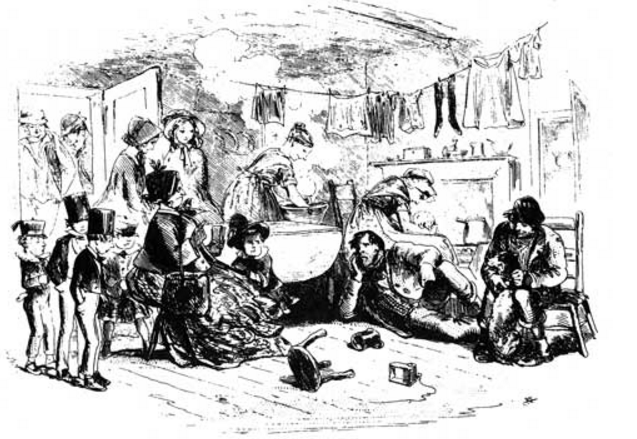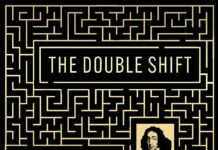by Megan Ward
This essay was peer-reviewed by the editorial board of b2o: an online journal.
Understanding how Bleak House resonates through time typically means understanding its echoes in the present moment. What, though, about the other futures of the Victorian novel that are our pasts? Today, I will mount a short argument for the place of Dickensian form in the long history of information systems. Though excellent analyses by scholars such as Anna Gibson, Jonathan Grossman, Caroline Levine, and Franco Moretti demonstrate the networked form of Dickens’s novels, they tend either to think of the network as historical context (the railway) or universal form (hubs and nodes) (Gibson 2015, Grossman 2012, Levine 2015, Moretti 2011). Instead, I wish to invoke Claude Shannon’s 1948 articulation of information theory, a mid-twentieth-century system that acts as both afterlife and model for the linked, predictive structures of Dickensian character.
Shannon’s innovation was to assess information as a measure of predictability rather than as specific pieces of knowledge. By measuring information in bits, Shannon divorced information from meaning. Predictability, for Shannon, measures of our ability to foretell the next signal based on what has come before, what Shannon calls measuring the “residue of influence” from one signal to the next (Shannon 1948: 15). Famously flat, Dickens’s characters have been both critiqued and rehabilitated on the question of predictability; as E.M. Forster famously pronounced, “If it never surprises, it is flat” (1974 [1927]: 118). But Forster’s idea of predictability measures individual interiority – measures knowledge, secrets, and revelations – while Shannon’s informatic understanding of predictability proves a better match for the networked form of Bleak House. By re-reading Dickens’s so-called flat characters as systems of networked predictability, we can see how the novel works to produce a system of unpredictable intimacies as information moves and imprints, leaving Shannon’s “residue”s.
Two brief examples: Lady Dedlock’s bootlegged portrait, which moves from Chesney Wold to a printed annual to the wall of the law clerk Jobling suggests we can actually know a character intimately from the circulation of a superficial image. Lady Dedlock’s “speaking likeness” generates not just the false intimacy we might attribute to the surface (or social media) but becomes a way of knowing and being known, instantiating her relationship to Esther and even, eventually, becoming a version of Esther herself, at least in Guppy’s formulation of Esther as the “image imprinted on my art.” (Dickens, 1996 [1863]: 470, 429).
Usually offered as evidence of predictability, Dickensian characters’ famous catch-phrases also work to connect characters in surprising ways across the text – and, in doing so, up-ends the very definition of predictability. For instance, Skimpole’s protestation that he is merely “such a mirthful child” connects him to the “graver childhood” of Charley, the perennially aged Smallweeds, and Esther, who becomes prematurely aged when John Jarndyce proposes that she reminds him of “the little old woman of the child’s (I don’t mean Skimpole’s) rhyme” (Dickens, 1996 [1863]: 226, 11). Skimpole’s abandonment of his own family – “all children” – links to the child he abandons, Jo, and to Lady Dedlock’s substitution of Rosa “my child” for Esther (Dickens, 1996 [1863]: 624, 421). Not simply a verbal tic, Skimpole’s “childishness” complicates the sense of knowing and being known usually attributed to unfolding interiority by attenuating these qualities across a system of circulating, widely-imprinting characters (Dickens, 1996 [1863]: 624).
Reading Bleak House through Shannon’s measure of predictability thus upsets the hierarchy of round over flat characters, of ineffable interiority over corporeal tic, even as it accounts for the vast fields of characters in the Victorian multi-plot novel. By historicizing the information system as a Victorian future that is also our past, we begin to re-think the entanglements of history and form – our literary forms may need theories that come from other histories. In articulating information theory in 1948, Shannon occupies the heart of what I recently termed the under-examined “historical middle.” In that middle lies the future of Bleak House, the past of the internet, and the present of informatic form.
References
Dickens, Charles. (1853) 1996. Bleak House. Ed. Stephen Gill. Oxford: Oxford University, Press.
Gibson, Anna. 2015. “Our Mutual Friend and Network Form.” NOVEL: A Forum on Fiction 48, no. 1, 63-84. novel.dukejournals.org.ezproxy.proxy.library.oregonstate.edu/content/48/1/63
Grossman, Jonathan. 2012. Charles Dickens’s Networks: Public Transport and the Novel. Oxford: Oxford University Press.
Levine, Caroline. 2015. Forms: Whole, Rhythm, Hierarchy, Network. Princeton and Oxford: Princeton University Press.
Morretti, Franco. 2011. “Network Theory, Plot Analysis.” New Left Review no. 68: 80-102. newleftreview.org/II/68/franco-moretti-network-theory-plot-analysis
Shannon, Claude. 1948. “A Mathematical Theory of Communication.” The Bell System Technical Journal 27: 379-423, 623-656.
CONTRIBUTOR’S NOTE
Megan Ward is assistant professor of English at Oregon State University. She is currently completing a book manuscript, Human Reproductions: Victorian Realist Character and Artificial Intelligence.




